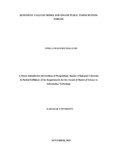SENTIMENT ANALYSIS MODEL FOR ONLINE PUBLIC PARTICIPATION FORUMS
Abstract
Public participation (PP) is a key constitutional principle outlined in the Constitution of
Kenya. It promotes democratic and accountable exercise of power. It gives the citizens
opportunity to enhance self-development and service delivery while accounting for their
leaders‘ actions. However, lack of/insufficient public participation in Kenyan county
governments is impeding effective devolution process. Among the reasons advanced for
this development are inadequate communications. Still even in cases where PP has been
successfully carried out, capturing and analysing the sentiments of the participants still
remain a serious challenge. Therefore, an online PP tool with embedded sentiment
analysis algorithms specifically designed for the counties can be quite resourceful under
the circumstances. The main objective of the study was to develop a sentiment analysis
model for use in public participation forums in County Governments in Kenya. The
specific objectives are to; evaluate the difficulty in obtaining sentiments; determine the
challenges faced in the design of an effective sentiment analysis model for public
participation forums; design a sentiment model for public participation forums in county
governments, and; evaluate the performance of sentiment analysis model for public
participation forums in county governments. The study was conducted through the
design thinking process. The population of interest in this study comprised of county
management and staff also area residents in Nakuru, Busia and Baringo counties who
have participated in public participation forums before. A sample size of 106 respondents
comprising 23 county administrators and 83 residents were purposively sampled for the
project. The sentiment analysis model was developed by implementing cloud NLP
package and Bidirectional Encoder Representations from Transformers (BERT)
algorithm to get magnitudes of user sentiments. Cross validation was then used to
evaluate the performance metrics at the design stage and users participated in the
evaluation of the model. The overall conclusion of validation is that the model performed
as expected and recorded instrumental results in increasing effective public participation
in county governments in Kenya and strengthen the devolution process. This study
recommends that the model can be cascaded to all the counties in Kenya to improve the
efficiency of public participation.

